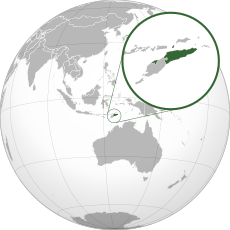Зүүн Тимор
Appearance
Бүгд Найрамдах Ардчилсан Зүүн Тимор Улс | |
|---|---|
Уриа: Unidade, Acção, Progresso (Португал) "Эв нэгдэл, Хөдөлгөөн, Хөгжил дэвшил" | |
| Төрийн дуулал: Патриа (Португал) "Эх орон" | |
| Нийслэл ба томоохон хот | Дили 8°33′S 125°34′E / 8.55°S 125.56°EСолбицол: 8°33′S 125°34′E / 8.55°S 125.56°E |
| Албан ёсны хэл | |
| Үндэсний хэлнүүд | |
| Ажлын хэл | |
| Шашин (2015 тооллого)[1] |
|
| Ард түмний нэршил | |
| Төр засаг | Нэгдмэл хагас-ерөнхийлөгчийн бүгд найрамдах улс[4] |
| Жозе Рамуш-Орта | |
| Шанана Гусман | |
| Хууль тогтоох байгууллага | Үндэсний Парламент |
| Түүх | |
| 16-р зуун | |
| 11 сарын 28, 1975 он | |
| 7 сарын 17, 1976 он | |
| 10 сарын 25, 1999 он | |
| 5 сарын 20, 2002 он | |
| Газар нутаг | |
• Нийт | 14,874 км2 (154) |
• Усны эзлэх талбай (%) | бага |
| Хүн ам | |
• 2021 тооцоо | 1,340,513 (153) |
• 2015 тооллого | 1,183,643[5] |
• Нягтаршил | 78/км2 (137) |
| ДНБ (ХАЧП) | 2023 тооцоо |
• Нийт | ▼ $5.0 тэрбум [6] (173rd) |
• Нэг хүнд ноогдох | ▼ $3,637[6] (157) |
| ДНБ (нэрлэсэн) | 2023 тооцоо |
• Нийт | ▼ $1.98 тэрбум[6] (183rd) |
• Нэг хүнд ноогдох | ▼ $1,425[6] (151) |
| ОТББИ (2014) | 28.7[7] бага |
| ХХИ (2021) | 0.607[8] дундаж · 140 |
| Мөнгөний нэгж | АНУ-ын долларb Зүүн Тимор центаво зоос (USD) |
| Цагийн бүс | UTC+9 (Зүүн Тиморын Цаг) |
| Жолооны тал | зүүн |
| Утасны томьёо | +670 |
| ISO 3166 код | TL |
| Домэйн нэр | .tlc |
| |
Зүүн Тимор, албан ёсоор Бүгд Найрамдах Ардчилсан Зүүн Тимор Улс нь Зүүн өмнөд Азид орших орон юм. Энэ оронд Тимор арлын тал, Атауро, Жака, Индонезийн эзэмшил дэх Баруун Тиморын Оэкусси-Амбено хамаарагддаг.
Цахим холбоос
[засварлах | кодоор засварлах]- Зүүн Тимор улсын албан ёсны цахим хуудас (англи хэлээр)
Эшлэл
[засварлах | кодоор засварлах]- ↑ "Nationality, Citizenship, and Religion". Government of Timor-Leste. 25 October 2015. Archived from the original on 14 July 2019. Татаж авсан: 29 January 2020.
- ↑ Hicks, David (15 September 2014). Rhetoric and the Decolonization and Recolonization of East Timor. Routledge. ISBN 9781317695356. Архивласан огноо 26 March 2023. Татаж авсан: 12 October 2020 – via Google Books.
- ↑ Adelman, Howard (28 June 2011). No Return, No Refuge: Rites and Rights in Minority Repatriation. Columbia University Press. ISBN 9780231526906. Архивласан огноо 26 March 2023. Татаж авсан: 12 October 2020 – via Google Books.
- ↑ Shoesmith, Dennis (2003). "Timor-Leste: Divided Leadership in a Semi-Presidential System". Asian Survey. 43 (2): 231–252. doi:10.1525/as.2003.43.2.231. Архивласан огноо 14 April 2021. Татаж авсан: 24 August 2020.
The semi-presidential system in the new state of Timor-Leste has institutionalized a political struggle between the president, Xanana Gusmão, and the prime minister, Mari Alkatiri. This has polarized political alliances and threatens the viability of the new state. This paper explains the ideological divisions and the history of rivalry between these two key political actors. The adoption of Marxism by Fretilin in 1977 led to Gusmão's repudiation of the party in the 1980s and his decision to remove Falintil, the guerrilla movement, from Fretilin control. The power struggle between the two leaders is then examined in the transition to independence. This includes an account of the politicization of the defense and police forces and attempts by Minister of Internal Administration Rogério Lobato to use disaffected Falintil veterans as a counterforce to the Gusmão loyalists in the army. The December 4, 2002, Dili riots are explained in the context of this political struggle.
- ↑ "Population by Age & Sex". Government of Timor-Leste. 25 October 2015. Archived from the original on 25 January 2020. Татаж авсан: 29 January 2020.
- ↑ 6.0 6.1 6.2 6.3 "World Economic Outlook Database, October 2022". IMF.org. International Monetary Fund. October 2022. Архивласан огноо 24 October 2022. Татаж авсан: October 11, 2022.
- ↑ "Gini Index coefficient". CIA World Factbook. Архивласан огноо 17 July 2021. Татаж авсан: 16 July 2021.
- ↑ "Human Development Report 2021/2022" (PDF) (англи хэлээр). United Nations Development Programme. 8 September 2022. Архивласан (PDF) огноо 8 September 2022. Татаж авсан: 8 September 2022.






